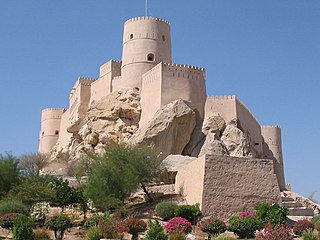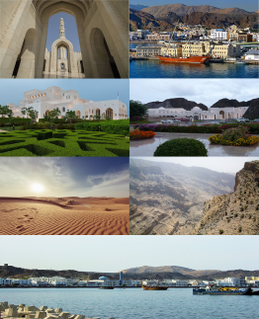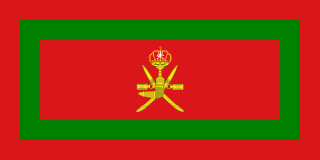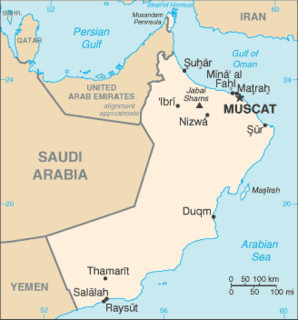
Oman is the site of pre-historic human habitation, stretching back over 100,000 years. The region was impacted by powerful invaders, including other Arab tribes, Portugal and Britain. Oman once possessed the island of Zanzibar, on the east coast of Africa as a colony.

Muscat is the capital and largest city of Oman. It is the seat of the Governorate of Muscat. According to the National Centre for Statistics and Information (NCSI), the total population of Muscat Governorate was 1.4 million as of September 2018. The metropolitan area spans approximately 3,500 km2 (1,400 sq mi) and includes six provinces called wilayat. Known since the early 1st century CE as an important trading port between the west and the east, Muscat was ruled by various indigenous tribes as well as foreign powers such as the Persians, the Portuguese Empire, the Iberian Union and the Ottoman Empire at various points in its history. A regional military power in the 18th century, Muscat's influence extended as far as East Africa and Zanzibar. As an important port-town in the Gulf of Oman, Muscat attracted foreign tradesmen and settlers such as the Persians and the Balochis. Since the ascension of Qaboos bin Said as Sultan of Oman in 1970, Muscat has experienced rapid infrastructural development that has led to the growth of a vibrant economy and a multi-ethnic society. Muscat is termed as a Beta - Global City by the Globalization and World Cities Research Network.

Qaboos bin Said Al Said was the Sultan of Oman from 23 July 1970 until his death. A fifteenth-generation descendant of the founder of the House of Al Said, he was the longest-serving leader in the Middle East and Arab world at the time of his death.

Ruwi is a commercial hub and the main business area of Muscat, the capital of the Sultanate of Oman. Among the key attractions here is a variety of multi-confessional religious buildings, an interesting and informative National Museum, and a beautiful Clock Tower and Park. Take the following tour to discover this wonderful part of Muscat. 85601 people live there.

Nizwa is the largest city in Ad Dakhiliyah Region in Oman and was the capital of Oman proper. Nizwa is about 140 km (87 mi) from Muscat. The population is estimated at around 72,000 people, including the two areas of Burkat Al Mooz and Al-Jabel Al-Akhdar.

The Sultanate of Muscat and Oman was a state that encompassed the present-day Sultanate of Oman and parts of present-day United Arab Emirates and Gwadar, Pakistan. Muscat courts' verdicts were based on Ibadi Islamic sharia law and appeals were raised to the Sultan of Muscat, who exercised supreme ruling.

The Al Alam Palace is a palace located in Old Muscat, Oman. It was used as a ceremonial palace by Sultan Qaboos bin Said Al Said.

This page list topics related to Oman.

The Al Busaidi dynasty is the ruling royal house of the Sultanate of Oman, and former ruling royal house of the Sultanate of Muscat and Zanzibar and the Sultanate of Zanzibar.

Bayt al Falaj is a village in Muscat, in northeastern Oman. It was the site of Muscat's airport and main operating base for the country's air force, prior to the opening of Muscat International Airport at Seeb in 1973.

Internal Security Service transliterated:Jahaz al Amn al Dakhly, is the national security agency of the Sultanate of Oman. The agency focuses solely upon domestic security while foreign intelligence operations is specifically handled by the Palace Office, which controls external security and coordinates all intelligence and security policies.

Hajj Moosa AbdulRahman Hassan was an Omani businessman, tribal leader, landlord & a Gulf icon; he was born in the old town of Muscat in 1902 and finished his studies in the American Mission School. He established a firm in 1927 in supplying coals and foodstuffs to British ships & frigates in Muscat.
Major General John David Carew Graham, was a British Army officer who was instrumental in the installation of Qaboos bin Said as Sultan of Oman in the 1970 Omani coup d'état.

The Royal Guard of Oman (RGO) is the royal guard of the Sultan of Oman. It is a separate service within the Sultan's Armed Forces (SAF) and although equipped to carry out land defense operations, it is not part of the Royal Army of Oman. The RGO is a personal security and ceremonial unit responsible for the protection of the Sultan and other senior members of the Royal Family.

Haitham bin Tariq Al Said is the Sultan of Oman. He succeeded his cousin Qaboos bin Said on 11 January 2020. He previously served as Minister of Heritage and Culture in the Sultanate of Oman.
The following is a timeline of the history of the city of Muscat, Oman.

The Oman Royal Yacht Squadron is the sultan's personal fleet of pleasure craft ranging from the grand Al Said through to the traditional wooden-hulled sailing vessel Zinat al Bihaar

The Royal Office transliterated:maktab al sultani is one of the most senior and therefore powerful ministries in the Sultanate of Oman. It is a government body that has most influence in national security and intelligence issues and the minister in charge has been the de facto national security advisor to the Sultan. The Palace Office also acts as a foreign liaison focus on all international intelligence and security matters.

The 1970 Omani coup d'état was the bloodless overthrow of Sultan Said bin Taimur by his son Qaboos bin Said in Oman on 23 July 1970. Occurring in the midst of the Dhofar Rebellion, the palace coup was executed with the support of the British military and saw Sultan Said bin Taimur deposed and sent into exile to the United Kingdom. The coup was a pivotal moment in modern Omani history as Sultan Qaboos swiftly set in motion numerous wide-ranging modernization reforms in the kingdom, transforming Oman from a backwater and underdeveloped state into a country on par with many Western nations in terms of peace and economic development. At the time of his death in January 2020, Sultan Qaboos was the longest serving ruler in the Middle East.
National Day is an official holiday in the Sultanate of Oman and the main one in the country. The holiday currently celebrates the History of Oman and specifically its independence from the Kingdom of Portugal. It also celebrates the birthday of Sultan Qaboos bin Said al Said, who reigned from 1970 to 2020.
















